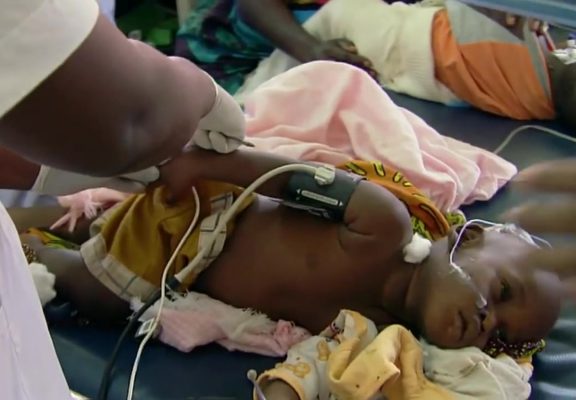

Zimbabwe
Zimbabwe is a landlocked country in southern Africa known for its dramatic landscape and diverse wildlife, much of it within parks, reserves and safari areas. On the Zambezi River, Victoria Falls make a thundering 108m drop into narrow Batoka Gorge, where there’s white-water rafting and bungee-jumping. Downstream are Matusadona and Mana Pools national parks, home to hippos, rhinos and birdlife. Its population is 14 million (2013) and GDP per capita of USD 953.
Zimbabwe’s economy has slowed dramatically, compromising government efforts to provide universal access to basic health services. The government aims to strengthen the health system through retention of health care workers, strengthening community health systems and scaling up programs for AIDS, TB and malaria. The country’s leadership role in increasing domestic financing through the AIDS levy has now been recorded and shared as international best practice. As one of the countries severely affected by the AIDS pandemic, Zimbabwe has recorded some internationally acclaimed milestones, particularly the reduction of HIV incidence and prevalence and increasing access to treatment. While the AIDS epidemic is in decline, the prevalence of HIV in Zimbabwe remains among the highest in the world. Zimbabwe focuses on treatment and prevention, voluntary counselling and testing, and prevention of mother-to-child transmission. Malaria is a major public health problem and efforts are focused on enabling people to identify early symptoms, building the capacity of health workers, and procuring rapid diagnostic tests. Zimbabwe ranks 17th among the 22 high-TB burden countries and the incidence of TB in Zimbabwe has increased dramatically in recent years, with TB now being the most common cause of death for people living with HIV. Work is underway to improve diagnosis and train health care workers.
AHO PRIORITIES FOR HEALTH DELIVERY IN ZIMBABWE
- Managerial capabilities and efficiency of the Representation and technical cooperation.
- Healthy lifestyles, including safe sex, physical activity, a healthy diet, prevention of violence, avoidance of smoking and drugs, and the general practice of healthy behaviours.
- Research initiatives for financing health care.
- Expansion and improvement of the quality of family planning services counselling and general services in collaboration with the Family Planning to facilitate achievement of the Population Policy target.
- Gender policies and activities, competence of management and support services, and physical facilities and equipment.
- Health sector reform, and the organization, management, financing, and delivery of health services.
- Disaster preparedness, with an emphasis on disaster planning and simulation exercises.
- Maternal and child health, with emphasis on reducing maternal mortality to under 10 deaths per 10,000 live births; reduction of perinatal mortality; and the elimination of poliomyelitis and measles.
- Oral health, with an emphasis on public education and monitoring of the Salt Fluoridation Project.
- Integration of mental health into primary care services.
- Public education and nutrition surveillance geared toward improving nutritional status and prevention of chronic diseases, targeting mainly diabetes and hypertension.
- Veterinary public health, with an emphasis on food-borne disease surveillance.
PROGRAMMES & PROJECTS
1. HEALTH SERVICES AND S YSTEMS DEVELOPMENT
PURPOSE
To strengthen the steering role of the Ministry of Health in the performance of essential public health functions (EPHF) and to gather information supporting the development and implementation of evidence-based policies.
EXPECTED RESULTS
- Evidence-based policies, norms, guidelines and standards formulated for relevant health services.
- New appropriate HR management approaches strengthened, developed, and implemented.
- Support provided for the expansion and reorganization of the MOH information systems (HIS) at the national and subnational levels .
- Partnerships forged for effective health input into social, economic, environmental, and developmental policies.
- Project coordination, monitoring, and evaluation system established for technical cooperation in HSSD.
- Support provided to the family health program through in-service training, social mobilization, and
- The strengthening of health services at subnational levels.
2. PROMOTION OF HEALTH AND DISEASE PREVENTION AND CONTROL
PURPOSE
To implement health promotion strategies and improve prevention and control programs
EXPECTED RESULTS
- Advocacy undertaken and partnerships forged to ensure provision of political, technical, and financial support for health promotion, prevention, and disease control.
- Planning, coordination, monitoring and evaluation system established for technical cooperation in health promotion and disease prevention and control.
- Evidence formulated for promoting health and disease prevention, considering different stages of the lifecycle, gender issues, and equity.
- Human resources developed and strengthened in the areas of health promotion and disease prevention and control (capacity building).
- Preventable immuno disease programs optimized.
3. ENVIRONMENTAL HEALTH AND DISASTER MANAGEMENT
PURPOSE
To develop and implement strategies to enable the health sector, in cooperation with other sectors, to achieve safe, sustainable, and health-enhancing physical and human environments.
EXPECTED RESULTS
- Advocacy undertaken and partnerships forged to provide political, technical, and financial support for safe, sustainable, and health-enhancing physical settings.
- Policies, norms, and standards formulated in the areas of physical environment, services and systems, settings and population in order to promote equity, prevent disease, reduce vulnerability to disasters, and improve quality of life.
- Support provided to the health sector in human resources development.
- Capacities strengthened in environmental health and disaster management in order implement strategies and action plans.
- Impact assessment undertaken of technology options and operational methodologies for environmental health and disaster management.
- Planning, coordination, monitoring and evaluation system established for technical cooperation in environmental health.
4. COORDINATION OF PROGRAMME SUPPORT
PURPOSE
To ensure greater efficiency and effectiveness in the delivery of technical cooperation
EXPECTED RESULTS
- Planning, coordinating, monitoring, and evaluating systems established for technical cooperation.
- Knowledge and skills of staff and infrastructure of representation improved.
- The capacity of AHO strengthened to reduce its vulnerability to natural disasters
RESOURCES (USD)
AHO ZIMBABWE 2019-2020 (USD million)* based on 2017 population of 16.53 million, World Bank
| SO | BUDGET ITEM | AMOUNT* |
| 1 | Combating communicable diseases |
275 |
| 2 | Tackling non communicable diseases |
300 |
| 3 | Addressing determinants of health & risk factors |
280 |
| 4 | Modernising health system and health service |
270 |
| 5 | Improving preparedness, surveillance and response |
273 |
| 6 | Developing good governance & corporate services |
255 |
| Total |
1,653 |
AHO estimates that it needs to spend at least USD100 per capita on health to meet the basic health needs of the people in Africa. This is too far below developed countries e.g. in England it is US$1,300 per capita (2017)



